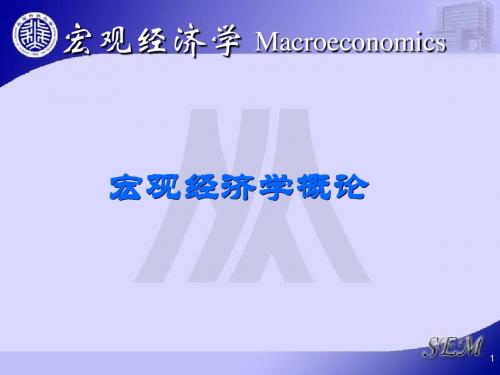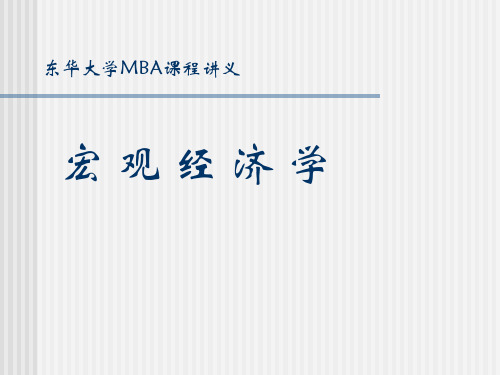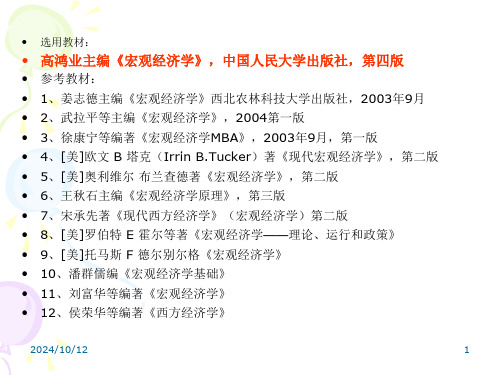宏观经济学导论 Introduction to Macroeconomics
宏观经济学习题及答案 (1)

Introduction to MacroeconomicsMultiple Choice Questions1.Macroeconomics is the study of ________ while microeconomics studies ________:a.firm behavior; market behaviorrge biological systems; political implications of nanotechnologyc.an individual firm; the overall economic performance of a nationd.the overall economic performance of the world; the economy of a single countrye.the overall economic activity and prices; an individual firm, household, or market2.An endogenous variable is typically:a.Taken as a given.b.Strictly explained by data.c.Strictly explained outside the model.d.Strictly explained inside the model.e.Strictly explained by graphical analysis.3.Which statement is true of an exogenous variable in an economic model?a.It is often a policy variable.b.It is explained inside the model.c.Its value within the model cannot be changed.d.It has no direct relation to the endogenous variables.e.All of the above.4.Macroeconomic models particularly focus on the following three economic data series.a.Inflation, unemployment, and business cycles.b.Bankruptcies, the unemployment rate, and depressions.c.Nominal GDP, the employment rate, and budget deficits.d.Endogenous variables, exogenous variables, and parameters.e.None of the above.Introduction to Macroeconomics5.An increase in government spending might be an example of a ________ policy for the purpose of :a.monetary; lowering unemploymentb.monetary; reducing inflationc.monetary; increasing savingd.fiscal; reducing inflatione.fiscal; lowering unemployment6.An increase in interest rates might be an example of a ________ policy for the purpose of:a.monetary; reducing inflationb.monetary; lowering unemploymentc.monetary; increasing the quantity of moneyd.fiscal; reducing inflatione.fiscal; lowering unemployment7.Nonactivists propose doing nothing in the face of economic hardship because:a."Markets self-correct pretty rapidly anyway".b.Activist policies can kick in at the wrong time and be counterproductive.c.In the face of high unemployment, activist policies would likely lead to surges in inflation.d.All of the above.e.None of the above.Introduction to MacroeconomicsDiscussion Questions1.Explain the difference between monetary policy and fiscal policy. What are some of the reasons that thesemacroeconomic policies are used?Fiscal policy refers to a government’s changing its taxes or spending or both.Monetary policy is a central bank’s control of interest rates and the amount of money in an economy.These policies are used for such purposes as influencing an economy’s saving rate, reducing or expanding the size of a government’s budget deficit, influencing the inflation rate and unemployment rate in an economy, or limiting business cycle fluctuations and stabilizing economic activity.2.What is stabilization policy? What two important debates occur among macroeconomists regarding its use andwho are the parties to these debates?Stabilization policy is the use of fiscal and monetary policies to stabilize economic activity by reducing business cycle fluctuations. One debate concerns how active stabilization policy should be. It pits nonactivists, macroeconomists who believe that the economy has a self-correcting mechanism that works rapidly to reduce unemployment without the need for stabilization policy, against activists who think this self-correcting mechanism is too slow and therefore call for the active use of fiscal and monetary policies to reduce unemployment when it is unacceptably high. A second debate arises between macroeconomists who advocate the use of policy rules to specify in advance precisely how policymakers must react to changes in unemployment or inflation and those who would allow policymakers greater latitude to use their discretionary judgment to formulate the policy response they believe is most appropriate in a given situation.3.For each of the following statements, explain which would make a reasonable hypothesis to test. Use theconcepts of normative and positive statements in your answers.a.Increases in the duration of unemployment benefits lead to higher rates of unemployment.b.Immigrations is bad for society.c.Increases in the labor force cause output to rise.d.Welfare payments make workers lazy.e.Higher tax rates increase work effort.Statements (a), (c), and (e) are positive statements that could be tested directly. Statements (b) and (d) are normative statements that involve value judgments and thus cannot be tested in an objective way.Introduction to Macroeconomics4.If you were studying the following relationships, which variable would be exogenous and which would beendogenous?a.The effect of investment growth on the growth rate of GDP.Investment, exogenous; GDP, endogenous.b.The relationship between the amount of sunshine and plant growth.Sunshine, exogenous; growth, endogenous.c.The relationship between hours of studying and grade point average.Studying, exogenous; GPA, endogenous.。
《宏观经济学》参考文献

《宏观经济学》参考文献一、各章参考文献第一章导论1、凯恩斯:《就业利息与货币通论》,商务印书馆1963年版。
2、Hall and Tayler, “Macroecnomics” , 2nd Ed., Norton Co. , New York, 1988, Chapter 13、蔡继明,《宏观经济学》,人民出版社2003年版,第一章。
4、高鸿业,《西方经济学(宏观部分)》,中国经济出版社1996年版,第一章。
5、宋承先,《现代西方经济学(宏观经济学)》,复旦高校出版社1999年版,第一章。
其次章宏观经济的衡量与均衡1、Hall and Tayler, <<Macroecnomics,> , 2nd Ed., Norton Co., New York, 1988, Chapter 22、蔡继明,《宏观经济学》,人民出版社2003年版,第一章。
3、高鸿业,《西方经济学(宏观部分)》,中国经济出版社1996年版,第一章。
4、宋承先,《现代西方经济学(宏观经济学)》,复旦高校出版社1999年版,第一章。
5、美国商务部,《当今商业概览》,1976年一月号。
第三章经济增长1、Jones, “An Introduction to Mordern Theories of Economic Growth,, , McGraw-Hill Co.,New York, 19762 > So low, ^Technical Change and Agregate Production Inunction n, in “Review of Economicsand Statistics” , 1957第四章失业1、凯恩斯:《就业利息与货币通论》,商务印书馆1963年版。
2、斯蒂格利茨,《经济学》(其次版),中国人民高校出版社2000年版。
3、兰荣华,《我们国家当前失业的缘由和再就业的措施》,载《上海铁道高校学报》2000年第7期。
01--第一章宏观经济学导论

新货币数量论
m M P
f
( y, w, rm , rb , re ,
1 p
dp dt
, )
自然率假说
政策主张: 赞同货币政策,反对财政政,
同时反对斟酌使用的货币政策; 主张单一政策规则
Chapter 1
30
1.4 从历史角度看宏观经济学:流派与方法之争
供给学派
理论核心:供给创造需求 本身
重点分析:供给效应 主要观点:关于边际税率
Chapter 1
33
1.5 宏观经济学研究的共同方法
宏观经济学把一个经济体系中所有的市场都综 合为三个市场:金融市场、商品市场和服务以 及劳动市场。
宏观经济分析建立在微观经济个体行为分析的 基础上。
宏观经济学在观察现实经济现象的基础上,加 上必要的假设,建立起理论模型,然后再利用 现实世界的数据来检验理论模型。
研究内容之五:国际经济 (International Economy)
封闭经济 开放经济
❖ 通货膨胀在国与国之间的传导 ❖ 外贸盈余与赤字对一国就业与财政的影响
Chapter 1
12
1.1宏观经济学的研究对象和内容
40
30
20
10
0 90 91 92 93 94 95 96 97 98 99 00 01
出口商品总额增长率(%) 年平均增长率14.15%
Chapter 1
出口商品总额(亿美元)
1990 620.9000 1991 718.4000 1992 849.4000 1993 917.4000 1994 1210.100 1995 1487.800 1996 1510.500 1997 1827.900 1998 1838.100 1999 1949.300 2000 2492.000 2001 2661.000
宏观经济学 Macroeconomics

•
14
1.4.2 经济理性主义假设
• 是现代西方经济学贯穿始终的最重要的假定 之一。是指在进行逻辑实证的研究过程中, 之一。是指在进行逻辑实证的研究过程中, 总是假定当事人非常明确行为的目标, 总是假定当事人非常明确行为的目标,在经 济决策时,总是深思熟虑的进行权衡比较, 济决策时,总是深思熟虑的进行权衡比较, 选择最佳方案,以期获得尽可能大的利益。 选择最佳方案,以期获得尽可能大的利益。 • 经济理性主义隐含了经济学研究对当事人追 求最大利益行为的肯定。 求最大利益行为的肯定。当事人从理性出发 选择的行为与社会最优相悖时, 选择的行为与社会最优相悖时,经济学不简 单的指责追求最大利益行为本身, 单的指责追求最大利益行为本身,而是探求 使当事人选择这种追求最大利益行为的外部 条件,如技术、资源、体制等。 条件,如技术、资源、体制等。
30
7
中国失业与通货膨胀
1978年以前,失业和通膨都是隐性的;改革开放后,失业和通膨成 为中国宏观经济中的一对主要矛盾。
125 120 115
4.0
3.5
3.0 110 2.5 105 100 95 78 80 82 84 86 88 90 92 94 96 98 00 2.0
1.5 78 80 82 84 86 88 90 92 94 96 98 00
12
1.4 宏观经济学的研究方法
• 1.4.1 实证分析方法 • 1.4.2 经济理性主义假设 • 1.4.3 均衡分析方法 • 1.4.4 静态、比较静态和动态分析方法 静态、 • 1.4.5 总量分析与个量分析 • 1.4.6 需求分析与供给分析 • 1.4.7 存量分析与流量分析 • 1.4.8 事前变量分析与事后
22
第一讲宏观经济学导论

-10
-20
-30 50 55 60 65 70 75 80 85 90 95 00
经济增长率(%)
2004-2008年中国GDP情况
排名
1 2 3 4 5 6 7 8 9 10
2008年世界各国最新GDP排名 国家 总值(亿美元) 人均(美元)
美国 日本 中国 德国 英国 法国 意大利 西班牙 加拿大 俄罗斯
政府要解决的主要问题
•判断宏观经济运行状态的主要依据
[资料]:
2002年拉美经济乌云密布
据联合国拉美经济委员会最近公布的一份报告,拉美经济今年 将出现0.8% 的负增长,人均产值负增长2.4%。报告称拉美地区的经 济前景“令人沮丧”。
报告指出今年上半年的拉美国内生产总值比去年同期下降3%。 今年的失业率将超过9%,上半年的通货膨胀率将达到8%,“从80年 代以来还没出现过这样的逆境。”
垄断的主要类型:自然垄断、经济垄断、法定垄 断、行政性垄断
为了对付垄断,政府可以实行公共管制,或在垄 断部门建立公共生产,并从效率和社会福利角度 规定价格。
市场失灵的主要表现之三:信息不充分
私人市场的所提供的信息往往不足,特别是随着 市场规模的扩大,信息越来越分散、复杂,生产 者和消费者都不能充分掌握必要信息,从而不可 避免地出现很多非理性决策,影响到竞争的充分 性,因此也会影响到市场机制的效率,这就需要 政府来提供信息。
按照古典经济学家的观点,市场也可以对经济波 动进行调节和矫正,但其是一种事后调节,是采 用经济危机的方式,对社会经济的破坏太大,代 价太高。因此,也需要政府对此进行干预和宏观 调控,以保持国民经济的稳定和发展。
课堂讨论
政府干预经济的主要手段有哪些? 当经济中出现大规模失业时?政府应如何
01宏观经济学导论

01宏观经济学导论第一章宏观经济学导论重点提示:本章需要重点把握宏观经济学的定义、研究对象和主要研究内容,了解宏观经济学的发展历程。
掌握宏观经济学的研究方法。
第一节宏观经济学的研究对象与主要内容经济学是研究如何有效配置和利用稀缺资源,以最大限度地满足人类社会需要的一门学问。
中国是一个转轨中的发展中大国。
改革开放以来经济发展已经成为中国政府的重要任务。
在发展的过程中,失业率、通货膨胀、国民收入增长水平、人民币汇率变动等经济问题成为公众普遍关注的问题。
如何认识并解决这些问题?这需要我们深入学习经济学,特别是宏观经济学。
作为一门社会科学,宏观经济学因研究对象及研究方法的不同从经济学中分离出来,成为经济学两大分支之一。
经济学的另外一大分支是微观经济学,主要研究稀缺资源的合理配置问题。
宏观经济学着重考察和说明国民收入、就业水平、价格水平等经济总量的决定和波动。
它因以国民经济总体过程活动为研究对象,所以又被称为总量分析或总量经济学。
挪威经济学家弗里希在1933年最先提出“宏观经济学”一词。
而在这之前,古典学派就早已对宏观经济现象进行过研究与考察。
法国重农学派创始人魁奈的《经济表》被认为是最早对资本主义生产总过程进行分析的经济学文献。
此后,宏观经济现象和微观经济现象很少被分割开来进行考察。
这一过程一直持续到凯恩斯的《就业、利息和货币通论》一书出版。
它的出现标志着宏观经济学的形成。
以收入和就业理论为基础的宏观经济分析此时才发展成为一门独立的经济分支学科。
一、宏观经济学的研究对象宏观的英文是“macro”,原意是“大”。
宏观经济学(Macroeconomics)是以整个国民经济为研究对象,通过研究经济总量的决定及其变化来说明社会究投资、出口、消费对拉动经济增长的分力影响和交叉渗透作用,研究失业现象时要考查失业因素并寻找解决失业问题的良性对策。
这些都是十分令人关切的主要宏观经济学问题。
第三,通货膨胀和经济周期问题。
经济学第一章宏观经济学导论

2024/10/12
10
• 如体育馆里坐着观赏球赛时,如果有一个 人为了看清楚些,就站起来,开始它可一 览无余;但其他观众效仿都站起来,大家 就会彼此遮挡,视野和原先大家坐着时的 效果一样或更差。这时,如果有少数人先 知先觉地意识到这种情况的荒谬或者站的 腿酸了,就会坐下来,大家效仿逐渐都坐 下来,则又回到原来的坐着的状态。
2024/10/12
11
• 单个家庭购车不会引起价格变化,所有家庭购车 就会引起价格变化;一个企业投资不会引起货币、 利率的变化,所有企业投资就会引起货币、利率 等变化。正像微观经济学中学到的:单个企业面 临的需求曲线是平行于横轴的,而行业的需求曲 线是向右下方倾斜的。
• 如果说微观经济学研究的是森林中的树木,宏观 经济学研究的则是森林整体,而不是其中的树木。 微观经济学以价格为中心被称为价格理论,宏观 经济学则以国民收入为中心,被称为收入理论。
2024/10/12
8
• 3、宏观经济学以国民收入决定理论为核心。通过 研究国民收入的决定来解决资源利用问题,分析 整个国民经济的运行。因此,国民收入决定理论 成为宏观经济学的核心,其他理论则是这一理论 的运用。宏观经济学也被称为“收入理论”。
• 4、宏观经济学进行的是总量分析。总量是反映整 个国民经济的综合变量,诸如国民收入、总就业 量、总消费、总投资、总储蓄、货币需求、货币 供给量等,总量分析就是研究这些总量如何形成 以及相互关系。
2024/10/12
4
• 天才失败了就是蠢才! • 多思、多想、多听、多看、谨言、慎行这
么做的好处就是让自己少一点后悔。我们 在做一件事之前要先想后果,要先往远处 想想,谨慎再谨慎,以求避免对他人的伤 害,减少自己之后的悔恨。说话要用脑子, 做事要考虑后果,这是为人处事的准则。
第1章宏观经济的基本指标及其衡量

02
价格水平及其衡量
01 衡量价格水平的主要指标
价格指数:同一组产品和服务在某一年的费用额同它在某一设定的基准年度(基 年)的费用额的比率。
• 常用的价格指数有两个:GDP平减指数和消费价格指数(CPI)。 GDP平减指数又称为GDP折算系数,用于衡量基年与本年度之间所发生的价格变化。
是重要的物价指数之一,它可以反映通货膨胀情况。
03 名义GDP和实际GDP
Nominal GDP & Real GDP
GDP=∑PiQi
为了比较真实反映当年产量的变动,GDP又区分为名义GDP和实际GDP。
名义GDP:指用生产物品和劳务的当年价格计算的全部最终产品的市场价值。 实际GDP:用以前某一年价格作为基期价格计算出来的全部最终产品的市场价值。
GDP测度的是最终产品的价值
GDP是一个市场价值的概念 01
GDP仅指市场活动导致的价值 06
GDP是一个地域概念
02
规则
05
03 GDP指一年内所生产而非所出售的最终产品价值
04 GDP是流量而非存量
几个问题:
01 电、牛奶、糖、面粉究竟是中间产品还是最终产品?
甲企业生产100万元最终产品,只卖掉80万元;乙企业也生产100万元最终产品,但
个人的购买行为 –耐用消费品(如小汽车、电视机、 洗衣机) –非耐用消费品(如食物、衣服) 劳务(如医疗、旅游、理发等) –不包括购买住宅的支出
01
政府购买:G
各级政府购买产品和劳务的支出。 —政府支出包括政府购买和政府转移 支付。但政府转移支付是对收入的再 分配,并不直接用于交换产品和服务, 所以不构成GDP的一部分。
)
B.建造一批厂房
- 1、下载文档前请自行甄别文档内容的完整性,平台不提供额外的编辑、内容补充、找答案等附加服务。
- 2、"仅部分预览"的文档,不可在线预览部分如存在完整性等问题,可反馈申请退款(可完整预览的文档不适用该条件!)。
- 3、如文档侵犯您的权益,请联系客服反馈,我们会尽快为您处理(人工客服工作时间:9:00-18:30)。
Resource prices, including wage rates The state of technology The rules of the game that provide production incentives
that as the price level increases,
other things constant, the
purchases of the four major
50
decision makers decline
AD
0 2 4 6 8 10 12 14 16
Real GDP trillions of 1996 dollars
More goods and services are available in the economy More people are employed
18
Short History of U.S. Economy
History of the U.S. economy can be crudely divided into four economic eras
Introduction to Macroeconomics
CHAPTER 5
© 2003 South-Western/Thomson Learning
1
Gross Domestic Product
GDP = Gross Domestic Product
Focuses on the U.S. economy
9
Leading Economic Indicators
Declines in leading economic indicators usually predict, or lead
to, a downturn and upturns point to an economic recovery
For example, in the early stages of a recession firms reduce overtime and new hiring, machinery orders slip, and the stock market turns down
15
Aggregate Supply Curve
Aggregate supply curve shows how much output U.S. producers are willing and able to supply at each price level, other things constant
Increases in the amount and quality of resources, especially labor and capital
Better technology
Improvements in the rules of the game that facilitate production and exchange
Since the early 1980s
• Good economic growth • Moderate increases in the price level
19
Exhibit 6: Decrease in Aggregate Demand between 1929 and 1933
Price level (1996 = 100)
• Was an era of generally strong economic growth • Moderate increases in the price level
From the early 1970s to the early 1980s
• High unemployment and high inflation
Aggregate demand is the relationship between the average price of aggregate output and the quantity of aggregate output demanded
11
Price Level
Average price of aggregate output is called the price level
3
Economic Fluctuations
Economic fluctuations
The rise and fall of economic activity relative to the long-term growth trend of the economy
4
Components of Business Cycles
Prior to and including the Greare often accompanied by a falling price level
After the Great Depression to the early 1970s
2
Flow and Stock Variables
Flow Variable
An amount per period of time Average spending per week, hours worked per month, etc.
Stock Variable
An amount measured at a particular point in time Amount of cash on hand you have now Number of housing units in existence today
Peak Trough
6
U.S. Growth
U.S. economy in 2001 was more than eleven times larger than in 1929 as measured by real gross domestic product – real GDP
Real GDP means the effects of changes in the economy’s price level have been stripped away the remaining changes reflect real changes in the value of
goods and services produced
7
Exhibit 2: Annual Percentage Change in U.S. Real GDP from 1929 to 2003
8
Increases in Production
Production tends to increase over the long run because of
16
Exhibit 5:Aggregate Demand & Supply
Equilibrium in the national
economy occurs where the
150
AD and AS curves intersect.
109 100
50
0
Price level (1996 = 100)
12
GDP Price Index
After adjusting GDP for price changes,
we end up with what is called the real gross domestic product, or real GDP
The GDP price index
Shows how the economy’s general price level changes over time Can be used to convert production in different years into dollars of constant purchasing power
Measures the market value of all final goods and services produced in the United States during a given period
Helps us keep track of the economy’s incredible variety of goods and services
The price level in any year is an index number, or reference number,
comparing average prices that year to average prices in some base, or reference, year
Milder contraction Decline in total output lasting at least two consecutive quarters
5
Exhibit 1: Hypothetical Business Fluctuations
A recession begins after the previous expansion has reached its peak, or high point and continues until the economy reaches a trough, or low point.
13
Aggregate Demand Curve
Aggregate demand curve shows the
relationship between the price level in the economy and the real GDP demanded, other things constant
